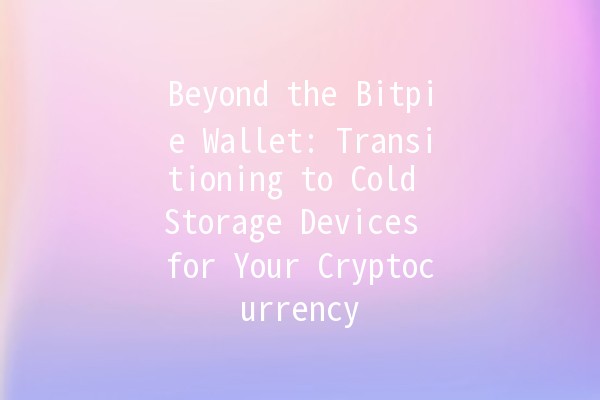
Understanding Cryptocurrency Storage
In the rapidly evolving world of digital currencies, security is paramount. Many cryptocurrency enthusiasts and investors use wallets to manage their assets. Among them, Bitpie Wallet has gained traction for its userfriendly interface and diverse functionalities. However, while wallets like Bitpie provide convenient access to your digital assets, the need for enhanced security is essential, especially as your investments grow. Transitioning to cold storage devices represents a prudent decision for safeguarding your cryptocurrency longterm.
What is a Cold Storage Device?
A cold storage device refers to any offline system where cryptocurrencies are stored and managed. Unlike hot wallets (like Bitpie), which are connected to the internet and can be vulnerable to hacking attempts, cold storage devices are kept off the grid. This added layer of security is particularly critical for individuals who hold significant amounts of cryptocurrency.
The Importance of Cold Storage

Steps to Transition from Bitpie Wallet to Cold Storage Devices
Before transitioning, assess how much cryptocurrency you currently hold and your future investment plans. Consider the following:
Volume of Investments: Are you holding significant amounts that justify cold storage?
Frequency of Transactions: Will you need to make regular transactions, or is this a longterm investment?
Security Concerns: Are you worried about potential hacking or theft of your assets?
Example Application: If you have a sizeable investment in Bitcoin and are not planning transaction activity frequently, cold storage will be essential. Conversely, if you are regularly using your cryptocurrency for purchases, maintaining a hot wallet for daily transactions while using cold storage for longterm holding could be a practical approach.
Cold storage options vary and include hardware wallets, paper wallets, and even airgapped computers. Here’s a breakdown:
Hardware Wallets: Devices like Ledger Nano X and Trezor Model T are popular choices. They store your private keys offline and have secure authentication features.
Paper Wallets: This involves generating a wallet on a secure system and printing the public and private keys on paper. Ensure the print is stored in a safe place to avoid theft or damage.
AirGapped Computers: Using an entirely offline computer dedicated to managing your cryptocurrency offers a highsecurity level by keeping it disconnected from all networks.
Example Application: Opt for a hardware wallet if you value convenience without sacrificing security. If you’re more comfortable with a DIY approach, create a paper wallet for each type of cryptocurrency you own.
Once you’ve selected a cold storage option, securely transfer your cryptocurrencies:
First, create your cold wallet (hardware wallet, paper wallet, etc.) and ensure it is properly set up.
Open your Bitpie Wallet and select the cryptocurrency you wish to withdraw.
Input the public address of your cold storage wallet and confirm the transaction.
Example Application: Make small test transfers before moving larger amounts. This will ensure everything is functioning correctly and the coins arrive safely.
After successfully transferring your cryptocurrencies, it's essential to back up your cold storage:
Create Multiple Copies: For paper wallets, create multiple copies and store them in different, secure locations.
Write Down Secure Phrases: Hardware wallets often provide a recovery phrase. Write this down, store it securely, and ensure you can access it if needed.
Example Application: Split the backup copies of your paper wallets among trusted family members or in a safety deposit box to protect them against loss.
Security is not a onetime task; regularly check and maintain your cold storage devices:
Update Firmware: For hardware wallets, ensure your device firmware is up to date.
Periodic Reviews: Check your cold storage setup and physical security measures every few months.
Security Drills: Conduct regular drills on restoring your assets to verify your backup process works smoothly.
Example Application: Set a calendar reminder to review your storage setup every quarter, ensuring your security practices remain strong.
Maximizing Your Cryptocurrency Management
To enhance your productivity and security while managing cryptocurrencies, consider implementing the following productivityenhancing techniques:
Frequently Asked Questions
Hot wallets, including Bitpie, are more vulnerable to cyber threats since they are connected to the internet. Risks include hacking, phishing attacks, and malware. For this reason, storing significant amounts in hot wallets is less secure than using cold storage solutions.
Robust cold storage security can be achieved by using hardware wallets, creating paper wallet backups, regularly reviewing your security measures, and following best practices with your backup procedures. Always ensure that your recovery phrases and keys are stored securely and in multiple locations.
If your device is a hardware wallet, you can restore access via the recovery phrase on a new device. For paper wallets, losses can be problematic unless you’ve created multiple backups stored securely. It’s crucial to keep recovery options handy.
Yes, hardware wallets combine security with convenient access. While they require an upfront investment (usually between $50$200), they significantly reduce the risk of losing your cryptocurrency through online theft or fraud.
To use assets stored in cold storage, you will need to transfer them back to a hot wallet or an exchange. This process typically requires you to withdraw your funds, which might take some time but is necessary for using those assets.
Immediately delete the email and report it to the relevant authorities. Never click on links from unsolicited emails, and consider regularly changing your security credentials for your hot wallet accounts.
Transitioning from a Bitpie wallet to offline cold storage represents a significant step toward enhancing the security of your cryptocurrency assets. By assessing your needs, selecting the right cold storage option, securely transferring assets, maintaining robust backup and recovery procedures, and regularly checking security measures, you can ensure that your digital investments are protected against unauthorized access and cyber threats. Investing in cold storage is a wise choice for anyone serious about cryptocurrency security. With the right practices, you can navigate the crypto landscape confidently and securely.

